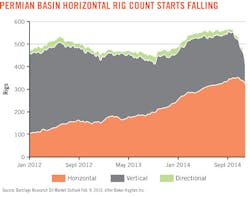EIA: Permian basin driving US shale oil production growth
Total US shale oil production was expected to increase by only 1,000 b/d in April compared with March, the Energy Information Administration forecast in its Drilling Productivity Report (DPR).
Expanding production in the Permian basin in Texas and New Mexico was expected to drive the overall increase. The DPR said Permian oil production during April was expected to climb 21,000 b/d higher than March. April oil production from the Permian was forecast to reach nearly 2 million b/d, the DPR said.
The pace of production growth from most US shale basins is holding steady or slowing this year as unconventional producers slash budgets, reduce rig counts, and stall completions while they wait for oil prices to stabilize and rebound (see story this issue, p. 7).
Total oil output from the most prolific shale areas in the Lower 48--the Bakken, Eagle Ford, Haynesville, Marcellus, Niobrara, Permian, and Utica--will remain virtually unchanged at 5.6 million b/d in April.
The DPR focuses on those seven plays, which accounted for 95% of US oil production increases and all US natural gas production increases during 2011-13.
Within the Permian, six formations have provided the bulk of a 60% increase in oil output since 2007. Crude oil production in the Permian has increased from a low point of 850,000 b/d in 2007, EIA noted last year.
The increase in Permian crude oil production is concentrated in six low-permeability formations: the Spraberry, Wolfcamp, Bone Spring, Glorieta, Yeso, and Delaware formations. Almost three-quarters of the production growth in recent years comes from the Spraberry, Wolfcamp, and Bone Spring formations.

